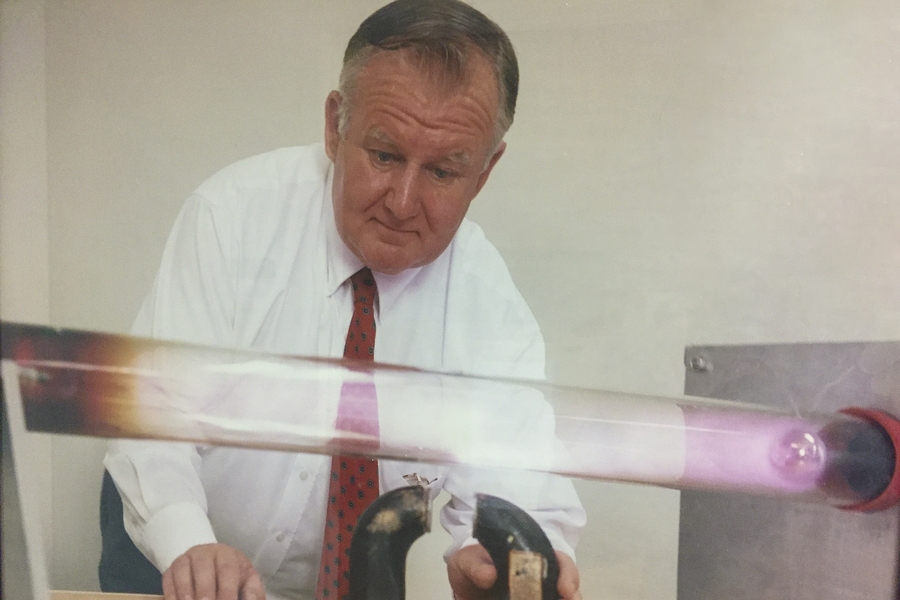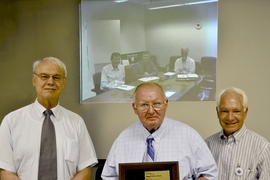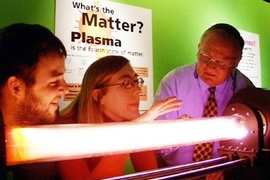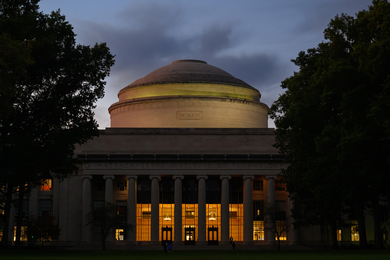Paul Thomas, best known as MIT’s “Mr. Magnet,” passed away peacefully on May 4 at the age of 77, after a five-year battle with Parkinson’s disease.
By the time he retired from MIT in 2014, the technical supervisor at the Plasma Science and Fusion Center (PSFC) had introduced over 500,000 school children to the mysteries of magnetism with his Mr. Magnet Science Show.
Thomas adopted the persona of “Mr. Magnet” when he became involved in PSFC in-house high school education activities, performing hands-on demonstrations for local students. He began visiting local schools in 1992, borrowing the center’s blue van to transport his demos. But as his hand-built demonstrations increased in number and size, he needed larger vehicles. At the height of the program, Mr. Magnet was transporting more than 6,000 pounds of equipment in a white cargo-styled truck, purchased by MIT. Although focusing on the local area, the program traveled as far as New Orleans, Louisiana, and made multiple appearances at the Science Bowl in Washington.
Thomas' rolling demonstrations, which he built in his lab or at home in his garage, allowed him to introduce students to magnetic levitation with a “floating frying pan,” or to demonstrate how magnets can be used to “magneform” metal foil into the shape of a dish. He could explain the electric force that attracts or repels matter using a Van de Graff generator, Rice Krispees, and ping pong balls. Thomas created a miniature “White House” equipped with numerous light bulbs that could only be lit by willing students generating electricity with their own muscle power. He built “The Boomer” based on Harold "Doc" Edgerton’s original plans, and used it to launch a plush Garfield toy, via a booming magnetic pulse, into the excited audience.
Through his program, students learned the importance of magnetism, the different ways to produce electricity, and the physics of particles and motion, all while laughing and having hands-on fun. Even when physical limitations forced Thomas to stop traveling, he continued to educate and entertain students at in-house events. He also created portable demonstrations for others to use at science expos and local schools.
While educating and entertaining K-12 students, Thomas was also mentoring MIT graduate students. He encouraged them to accompany him when he traveled to schools, and incorporated them into his PSFC outreach day demonstrations, showing by his example how to engage students with presence and humor, inspiring a next generation of educators.
Arturo Dominguez PhD '13, science education senior program leader at Princeton Plasma Physics Laboratory, was one of those students. "When I arrived at the PSFC as an incoming graduate student,” he remembers, “it was clear that public outreach was highly valued, and this effort was led by Paul Thomas. His passion for getting students of all ages excited about science and engineering was infectious and was a great source of inspiration for me and a big reason I decided to dedicate my professional life to outreach and science education."
The Mr. Magnet program received local and national acclaim as a model for bringing the excitement of science to the minds and the hearts of young people. In recognition of his service and abilities, MIT honored Thomas with several awards, including the Gordon Y. Billard Award (1997), the Infinite Mile Award (2001) and the Excellence Award (2001). In 2010 he received an Appreciation Award from the U.S. Department of Energy, which provided some support for the program, as well as a Governor’s Citation from Massachusetts Governor Deval Patrick and Lieutenant Governor Timothy P. Murray “in recognition of nearly 20 years of dedicated service to the ‘Mr. Magnet’ program.”
Born Dec. 16, 1942 in Newton, Massachusetts, Thomas became interested in engineering when, as a boy, he repeatedly took apart and reassembled his parents’ toaster and radio. He attended Wellesley High School through his junior year, graduating from Natick High School in 1960. After graduating from technical school, Thomas joined High Voltage Engineering Corporation and worked under the guidance of Robert J. Van de Graaff developing high voltage apparatus for research. He joined MIT in 1983, where, as part of a team of scientists and engineers he supervised the integration of computer controls on a large-scale fusion experiment.
At the Plasma Science and Fusion Center, Thomas worked on a number of projects, including a plasma arc furnace and a continuous emissions monitoring system for incinerators and power plants, both related to nuclear waste remediation and funded by the U.S. Department of Energy. A colleague on this project, Principal Research Engineer Leslie Bromberg, remembers Thomas as great supervisor and mentor: “He had a number of students, technicians, and interns under his supervision, and was always interested in their development as well as in completing the tasks at hand. His eagerness to help and his experience was invaluable, keeping us safe and on schedule. His enthusiasm, good humor, and eagerness to go above and beyond energized the group.”
Thomas was a loving family man. He met his one true love, Louise Geary, at a town dance when he was 15 years old. Married in 1966, they celebrated 50 years together in 2016. Thomas was committed to his two sons, coaching them in sports, and taking an active role in their educational interests. An avid fisher, he looked forward to fishing expeditions with his sons and great-nieces.
Thomas is predeceased by his wife Louise (2018), and survived by sons Peter Thomas and Oakley Thomas and family; nieces Debbie Hayes and fiancé Julio Fontecchio and Diane Byrne and husband Walter; and great-nieces Katie Hausken and husband Krist, Holly Hayes, Mary Byrne, and Laura Byrne. He is predeceased by his brother, Theodore, and sister, Roberta.
Donations in his memory may be made to the Parkinson’s Disease and Movement Disorders Center at the Boston Medical Center, Shapiro Center, 725 Albany Street, 7th Floor, Suite 7B, Boston, MA 02118.








